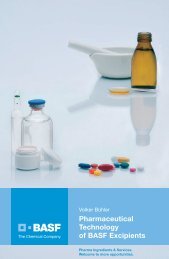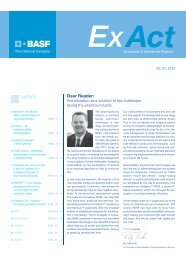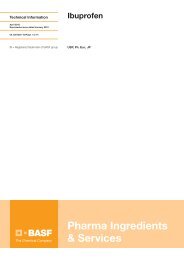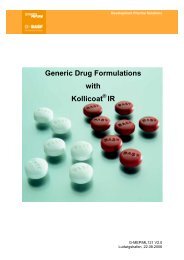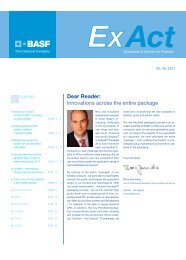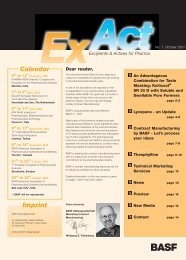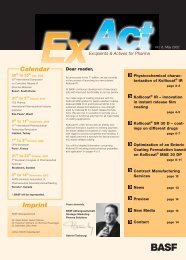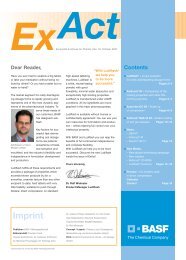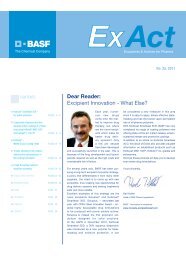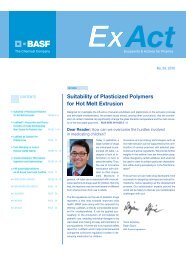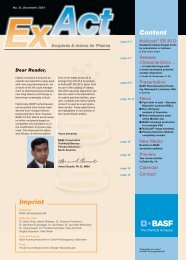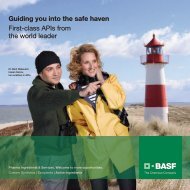Film Coating: Scuffing - Pharma Ingredients & Services BASF
Film Coating: Scuffing - Pharma Ingredients & Services BASF
Film Coating: Scuffing - Pharma Ingredients & Services BASF
Create successful ePaper yourself
Turn your PDF publications into a flip-book with our unique Google optimized e-Paper software.
Excipients & Actives for <strong>Pharma</strong> | No. 21, October 2008<br />
Dear Reader,<br />
Time-to-market is becoming increasingly<br />
important for pharmaceutical companies.<br />
The faster a new product is introduced onto<br />
the market, the longer the originator benefits<br />
from its development due to the remaining<br />
patent-protection period. Speed is also of<br />
the essence for producers of generics, as<br />
the first-to-market strategy ensures a high<br />
market share. On the other hand, regulatory<br />
authorities and in-house guidelines call for<br />
ever more detailed and time-consuming<br />
documentation.<br />
Fulfilling both these<br />
requirements reduces<br />
the time available for<br />
optimizing formulations<br />
and processes within<br />
the scope of ongoing<br />
projects. Obstacles<br />
encountered during in<br />
the formulation phase<br />
Thorsten Cech<br />
frequently lead to time<br />
Manager, European <strong>Pharma</strong><br />
pressure. Concessions<br />
Application Lab<br />
are required to make<br />
up for lost time. In daily work a great deal<br />
of a valuable time is needed to solve minor<br />
problems that arise during routine processes<br />
like granulation, tableting and coating.<br />
This is where <strong>BASF</strong> comes in. To investigate<br />
the performance of our excipients, we continuously<br />
conduct trials involving various<br />
pharmaceutical technologies. We not only<br />
“…we provide<br />
you with expert<br />
develop numerous<br />
advice on how<br />
generic drug formulations,<br />
but also run<br />
to improve the<br />
quality and efficiency<br />
of your<br />
processes under different<br />
conditions. Borderline<br />
processes are development and<br />
of particular interest manufacturing<br />
to us, as they help us processes”<br />
to better understand<br />
the performance of our products. Furthermore,<br />
close relationships with a number of<br />
manufacturers of pharmaceutical technologies,<br />
and regular exchange of ideas and<br />
experience enable us to act on our findings.<br />
By gathering and appraising all this information,<br />
we provide you with expert advice on<br />
how to improve the quality and efficiency of<br />
your development and manufacturing<br />
processes.<br />
This edition of ExAct sees the launch of our<br />
new Troubleshooting column. In the following<br />
issues, we plan to discuss a specific problem<br />
and its solution. We hope this will support you<br />
in your your daily work and help you gain<br />
valuable time.<br />
Yours sincerely,<br />
Thorsten Cech<br />
Manager, European <strong>Pharma</strong> Application Lab<br />
Contents<br />
Plasticizers – Influence of Plasticizer on<br />
<strong>Film</strong> Properties<br />
Pages 2-5<br />
Kollicoat ® – Reliability of Drug Delivery<br />
Systems<br />
Pages 6-8<br />
Propylene Glycol – Implementation of<br />
GMP Standard<br />
Page 9<br />
Troubleshooting – <strong>Film</strong> <strong>Coating</strong>: <strong>Scuffing</strong><br />
Pages 10-12<br />
News:<br />
– Kollicoat IR: Draft Monograph for the<br />
European <strong>Pharma</strong>copoeia<br />
– USP: <strong>Pharma</strong>ceutical Ingredient<br />
Verification Program<br />
– Regulatory affairs<br />
Page 13<br />
Workshops Page 14<br />
New Media:<br />
– Booklet: <strong>Pharma</strong>ceutical Technology of<br />
<strong>BASF</strong> Excipients<br />
– Ludipress ® Brochure<br />
– Kollicoat Poster<br />
Page 15<br />
Imprint<br />
Publisher: <strong>BASF</strong> SE<br />
Editorial staff: Michael Black, Suzanna Brown,<br />
Thorsten Cech, Hubertus Folttmann, Bernd Fussnegger,<br />
Felicitas Guth, Philipp Hebestreit, Karl<br />
Kolter, Kathrin Meyer-Boehm, Sascha Opaska, Inge<br />
Rademacher, Claudia Schneider, Florian Wildschek<br />
Concept/layout:<br />
Château Louis Strategische Markenführung und<br />
Kommunikation GmbH<br />
Print:<br />
Grosch! Druckzentrum, Druck- und Verlags- GmbH<br />
Preview:<br />
Melt Extrusion for<br />
<strong>Pharma</strong>ceuticals<br />
Calendar<br />
Contact Page 16<br />
Trademarks are owned by <strong>BASF</strong> SE
Excipients & Actives for <strong>Pharma</strong><br />
Influence of Plasticizers on the <strong>Film</strong> Properties of<br />
HPMC and PVA and Comparison of the Results with the<br />
Properties of Kollicoat ® IR as a single <strong>Film</strong> Former<br />
By Thorsten Cech 1 (thorsten.cech@basf.com), Karl Kolter 2 (karl.kolter@basf.com)<br />
1<br />
<strong>BASF</strong> SE, European <strong>Pharma</strong> Application Lab, 67056 Ludwigshafen, Germany<br />
2<br />
<strong>BASF</strong> SE, Development <strong>Pharma</strong> <strong>Ingredients</strong>, 67056 Ludwigshafen, Germany<br />
INTRODUCTION<br />
In the field of instant release<br />
film coating a wide range of<br />
film forming polymers can be<br />
used. Even if the application<br />
is the same, the film forming<br />
characteristics of the polymers<br />
hydroxy propyl methylcellulose<br />
(HPMC), polyvinyl alcohol (PVA)<br />
and Kollicoat IR are completely<br />
different [1]. HPMC 3mPas is a<br />
very brittle film former, whereas<br />
PVA was found to be extremely<br />
supple. In contrast, Kollicoat IR<br />
offers a broad range of usable<br />
process parameter settings.<br />
To improve the application properties<br />
of HPMC and PVA additional<br />
excipients have to be<br />
added to the formulation, among<br />
them plasticizers.<br />
OBJECTIVE<br />
This paper aims to investigate<br />
the influence of plasticizers on<br />
the film-coating properties of<br />
HPMC 3mPas and PVA. Since<br />
Kollicoat IR was found to form<br />
stable film without any additives,<br />
for example plasticizers, this<br />
product is used by itself as a<br />
reference.<br />
Of particular interest were the<br />
changes in water vapor transmission<br />
rate (WVTR) and elongation<br />
at break.<br />
EXPERIMENTAL<br />
Materials<br />
Table 1 shows the formulations<br />
tested regarding their WVTR and<br />
their elongation properties.<br />
For the film coating trials, HPMC<br />
3mPas and PVA in combination<br />
with 10% PEG 6000 were used.<br />
Equipment<br />
<strong>Film</strong> Caster: Coatmaster, Erichsen<br />
Testing Equipment (Germany);<br />
Transmission Tester: Permatran,<br />
Mocon (USA);<br />
Texture Analyser: TA-XT2i HR,<br />
Stable Micro Systems (UK);<br />
Drum Coater: AccelaCota 24”,<br />
Manesty (UK)<br />
Methods<br />
The parameters of comparison<br />
were the following:<br />
Viscosity of the polymer<br />
solution<br />
(25°C, w/w = 20%)<br />
Elongation at break<br />
(at 23°C/54 % r.h.)<br />
Water vapor transmission<br />
rate [3]<br />
(23°C/0% r.h. – 23°C/85% r.h.)<br />
<strong>Coating</strong> parameters<br />
without plasticizer and<br />
with 10% PEG 6000 added<br />
Table 1: Formulations tested<br />
Table 2: Viscosity and Elongation at Break of the Polymers without<br />
additional Plasticizers<br />
Polymer Plasticizer Quantity [%]<br />
Polymer Viscosity [mPas] Elongation at break [%]<br />
Kollicoat IR non –<br />
HPMC 3mPas propylene glycol (PG) 5, 10, 20, 40<br />
propylene glycol (PEG) 400 10, 20, 40<br />
propylene glycol (PEG) 6000 5<br />
triacetin (TAC) 5, 10, 20, 40<br />
triethyl citrate (TEC) 5, 10, 20, 40<br />
PVA propylene glycol (PG) 5, 10, 20, 40<br />
propylene glycol (PEG) 400 5, 10, 20, 40<br />
propylene glycol (PEG) 6000 5, 10, 20<br />
Kollicoat IR 91 169<br />
HPMC 3mPas 561 4<br />
PVA 590 226
No. 21, October 2008 | PAGE 3<br />
Due to the brittleness of some<br />
cast films containing PEG 6000,<br />
not all formulations could be prepared.<br />
Furthermore, the lipophilic<br />
plasticizers TEC and TAC could<br />
not be used in the combination<br />
with PVA. A separation of the<br />
plasticizer was observed.<br />
to have a very high elasticity,<br />
whereas HPMC 3mPas was brittle<br />
and therefore low in elongation<br />
at break (Table 2).<br />
The change in elongation at<br />
break when different quantities<br />
of plasticizer were added was<br />
determined.<br />
RESULTS<br />
Viscosity<br />
HPMC 3mPas and PVA were found<br />
with quite similar viscosities of its<br />
polymer solutions (w/w = 20%).<br />
With nearly 600 mPas, the solutions<br />
tested could hardly be used<br />
as coating solution. Kollicoat ® IR<br />
showed significant flow properties<br />
(Table 2). With less than 100<br />
mPas, the solution is still easily<br />
usable for film coating processes.<br />
Elongation at Break<br />
PVA and Kollicoat IR were found<br />
Surprisingly, the influence of<br />
plasticizers on the elongation at<br />
break was quite low. Compared<br />
to the properties of the polymer<br />
itself, elasticity increased just<br />
slightly with relevant plasticizer<br />
contents.<br />
Just with 40% plasticizer added,<br />
a significant increase in elongation<br />
at break could be determined<br />
(Figure 1 and 2).<br />
The determination clearly showed<br />
that the elongation prop erties<br />
Elongation at break test equipment: Texture Analyser, TA-XT2i HR, Stable Micro Systems<br />
could not be influenced by Water Vapor Transmission<br />
adding plasticizer. Therefore, if Rate (WVTR)<br />
cracks in the applied film occur There is an ongoing discussion if<br />
during storage, additional plasticizer<br />
cannot prevent this effect. vapor transmission. The<br />
plasticizers support the water<br />
tested<br />
Figure 1 – Elongation at break of PVA as function of plasticizer and<br />
plasticizer content<br />
Figure 2 – Elongation at break of PVA as function of plasticizer and<br />
plasticizer content<br />
15.0<br />
elongation at break [%]<br />
450<br />
elongation at break [%]<br />
12.5<br />
10.0<br />
PG<br />
PEG 400<br />
PEG 6000<br />
TAC<br />
TEC<br />
400<br />
350<br />
PG<br />
PEG 400<br />
PEG 6000<br />
TAC<br />
TEC<br />
7.5<br />
300<br />
5.0<br />
250<br />
2.5<br />
200<br />
0.0<br />
150<br />
O 5.0 10.0 15.0 20.0 25.0 30.0 35.0 40.0 45.0<br />
plasticizer content [%]<br />
O 5.0 10.0 15.0 20.0 25.0 30.0 35.0 40.0 45.0<br />
plasticizer content [%]
Excipients & Actives for <strong>Pharma</strong><br />
CONCLUSIONS<br />
polymers can be used as a base<br />
for moisture-protective coatings.<br />
Therefore, it was useful to determine<br />
the WVTR, even if the main<br />
protection depends on the<br />
amount of pigments contained in<br />
the film formulation [2].<br />
In this study, trials were carried<br />
out to determine the influence of<br />
plasticizers on the WVTR [3]. The<br />
WVTR was found to be lower<br />
with relevant plasticizer contents.<br />
Plasticizer used in a ratio of up<br />
to 20% supported the protective<br />
properties of the tested films<br />
(Figure 3 and 4).<br />
<strong>Coating</strong> Properties<br />
The coating properties were<br />
determined by using Process-<br />
Parameter-Charts [4].<br />
HPMC 3 mPas was found to be<br />
a brittle film former. A product<br />
temperature above 43–45°C<br />
caused defects in the film surface<br />
(Figure 5). Adding PEG<br />
6000 improved the coating properties<br />
significantly (Figure 6).<br />
PVA, on the contrary, was found<br />
to be a very supple film former.<br />
As water acts as a plasticizer,<br />
coating was only possible under<br />
very dry conditions (low spray<br />
rate, high product temperature)<br />
(Figure 7). The addition of PEG<br />
6000 improved the coating properties<br />
of PVA as well (Figure 8).<br />
Just in this case, PEG 6000<br />
worked very differently, as it is<br />
not acting as a plasticizer. Having<br />
a molecular weight of about<br />
6000 Daltons PEG 6000 is a brittle<br />
film former in its own right.<br />
By mixing PVA with PEG 6000<br />
the properties of the two film<br />
Kollicoat ® IR offers the lowest dynamic viscosity, enabling high<br />
solid matter contents and short process times.<br />
The elongation properties of HPMC 3mPas can hardly be<br />
improved by adding various plasticizers.<br />
WVTR can be reduced slightly by adding some plasticizer.<br />
Adding PEG 6000 to a HPMC-3mPas-based formulation reduces<br />
the brittleness of the film (the film becomes foldable)<br />
without improving its elasticity (or flexibility which is responsible<br />
for potential cracks in the applied film).<br />
As PEG 6000 decreases the brittleness of the formed polymer<br />
film, the coating properties of HPMC 3mPas can be improved<br />
significantly.<br />
The coating properties of PVA can be improved significantly by<br />
adding PEG 6000.<br />
Kollicoat IR has far superior coating properties.<br />
formers were combined. Hence,<br />
the coating properties were<br />
improved.<br />
However, the characteristics of<br />
the two polymers could be positively<br />
influenced by adding plasticizers<br />
like PEG, the coating<br />
results with Kollicoat IR still<br />
remained better (Figure 9).<br />
Figure 3 – WVTR of HPMC 3mPas as function of plasticizer and plasticizer<br />
content<br />
Figure 4 – WVTR of PVA as function of plasticizer and plasticizer content<br />
1000<br />
elongation at break [%]<br />
1000<br />
elongation at break [%]<br />
900<br />
800<br />
700<br />
600<br />
PG<br />
PEG 400<br />
PEG 6000<br />
TAC<br />
TEC<br />
900<br />
800<br />
700<br />
600<br />
PG<br />
PEG 400<br />
PEG 6000<br />
TAC<br />
TEC<br />
500<br />
500<br />
400<br />
400<br />
300<br />
300<br />
200<br />
200<br />
100<br />
100<br />
0<br />
0<br />
O 5.0 10.0 15.0 20.0 25.0 30.0 35.0 40.0 45.0<br />
O 5.0 10.0 15.0 20.0 25.0 30.0 35.0 40.0 45.0<br />
plasticizer content [%]<br />
plasticizer content [%]
No. 21, October 2008 | PAGE 5<br />
Figure 5 – Process-parameter-chart of HPMC 3mPas<br />
Figure 6 – Process-parameter-chart of HPMC 3mPas, 10% PEG 6000 added<br />
50<br />
45<br />
40<br />
35<br />
product temperature [°C]<br />
50<br />
45<br />
40<br />
35<br />
product temperature [°C]<br />
30<br />
30<br />
25<br />
25<br />
20<br />
20<br />
25 75 125 175 225 275<br />
total process time [min]<br />
15<br />
25 75 125 175 225 275<br />
total process time [min]<br />
15<br />
Figure 7 – Process-parameter-chart of PVA<br />
Figure 8 – Process-parameter-chart of PVA, 10% PEG 6000 added<br />
50<br />
45<br />
40<br />
35<br />
product temperature [°C]<br />
50<br />
45<br />
40<br />
35<br />
product temperature [°C]<br />
30<br />
30<br />
25<br />
25<br />
20<br />
20<br />
25 75 125 175 225 275<br />
total process time [min]<br />
15<br />
25 75 125 175 225 275<br />
total process time [min]<br />
15<br />
Figure 9 – Process-parameter-chart of Kollicoat ® IR<br />
50<br />
45<br />
40<br />
35<br />
30<br />
25<br />
20<br />
product temperature [°C]<br />
REFERENCES<br />
[1] T. Cech, K. Kolter; Comparison of the <strong>Coating</strong> Properties of Kollicoat ® IR and other<br />
<strong>Film</strong> Forming Polymers Used for Instant Release <strong>Film</strong>-<strong>Coating</strong>, ExcipientFest<br />
Europe, June 19.-20., 2007, Cork, Ireland,<br />
[2] T. Cech, K. Kolter; Developing an Instant Release Moisture Protective <strong>Coating</strong> Formulation<br />
based on Kollicoat ® Protect as <strong>Film</strong> Forming Polymer; PBP World Meeting 2008<br />
[3] ASTM F-1249<br />
[4] T. Cech, K. Kolter; Comparison of the <strong>Coating</strong> Properties of Instant Release <strong>Film</strong><br />
<strong>Coating</strong> Materials Using a Newly Developed Test Method – the Process-Parameter-<br />
Chart, PSWC 2007<br />
Published in ExcipientFest Europe, June 17.-18., 2008, Cork, Ireland, G-EMP/MD<br />
25 75 125 175 225 275<br />
total process time [min]<br />
15
Excipients & Actives for <strong>Pharma</strong><br />
Reliability of Drug Release from Innovative Single-Unit<br />
Kollicoat ® Drug Delivery Systems<br />
K. Meyer-Boehm and K. Kolter (karl.kolter@basf.com)<br />
<strong>BASF</strong> SE, R&D Project Management Excipients, 67056 Ludwigshafen, Germany<br />
ABSTRACT/SUMMARY<br />
Sustained-release characteristics<br />
as well as the influence of<br />
mechanical stress on the new<br />
single-unit Kollicoat DDS was<br />
investigated. The delivery system<br />
showed a reliable release profile,<br />
a self-repair mechanism and<br />
bursting forces of the swollen<br />
system greatly exceeding the<br />
maximum contraction strength in<br />
the human stomach and intestine.<br />
Thus, dose dumping should<br />
not be a risk.<br />
INTRODUCTION<br />
In the past, there was only one<br />
coated single-unit drug delivery<br />
system available, which was<br />
quite complex and difficult to<br />
produce, the OROS-system [1].<br />
Mainly the risk of dose dumping<br />
prohibited the development of<br />
other systems. Recently, innovative<br />
single-unit drug delivery<br />
systems have been developed,<br />
releasing the drug by diffusion<br />
through a membrane. These<br />
sustained-release dosage forms<br />
are produced by coating a tablet<br />
core with a combination of very<br />
flexible hydrophilic (Kollicoat IR)<br />
and lipophilic (Kollicoat SR 30 D)<br />
polymers [2]. This combination<br />
does not require organic solvents<br />
and produces a strong sustained-release<br />
effect.<br />
Generally, due to the structure<br />
and the principle of release there<br />
might be the risk of dose dumping.<br />
Therefore, the safety and<br />
mechanical stability of this<br />
dosage form was investigated<br />
using pseudophedrine HCl as<br />
model drug.<br />
EXPERIMENTAL METHODS<br />
Immediate release pseudo ephe -<br />
drine HCl cores (9mm diameter)<br />
were manufactured by blending<br />
all ingredients for 10 min in a turbula<br />
mixer and direct compression<br />
on a Korsch PH 106 rotary<br />
press at 10 kN compression<br />
force.<br />
<strong>Coating</strong> was performed in a 24”<br />
Accela Cota perforated pan<br />
coater.<br />
Dissolution was determined in<br />
paddle equipment with 0.08N<br />
HCl for 2h and a subsequent<br />
pH-change with phosphate<br />
buffer to pH 6.8 at a stirring<br />
speed of 50 rpm.<br />
Table 1: Composition of pseudoephedrine<br />
cores<br />
Ingredient<br />
[mg]<br />
Pseudoephedrine HCI 120.0<br />
Ludipress ® 274.0<br />
Aerosil ® 200 2.0<br />
Magnesium stearate 4.0<br />
Total 400.00<br />
Table 2: <strong>Coating</strong> composition<br />
SR : IR<br />
7 : 3 8 : 2<br />
[%] [%]<br />
Kollicoat SR 30 D 37.77 43.17<br />
(polyvinyl acetate 30% dispersion, <strong>BASF</strong>)<br />
Kollicoat IR 4.86 3.24<br />
(polyvinyl aclohol-polyethylene glycol graft copolymer, <strong>BASF</strong>)<br />
Triacetin 1.62 1.62<br />
Talc 4.05 4.05<br />
Water 51.70 47.92<br />
Total 100.0 100.0<br />
Table 3: <strong>Coating</strong> parameters<br />
Inlet air temperature 60° C<br />
Outlet air temperature 35° C<br />
Spraying rate<br />
32 g/min<br />
Atomizing pressure 1.5 bar<br />
Nozzle<br />
1.0 mm
No. 21, October 2008 | PAGE 7<br />
0 min 90 min 210 min<br />
Mechanical stability of swollen<br />
tablets after various release<br />
times was tested using a Texture<br />
Analyzer (TA-XT2 HiR; Stable<br />
Micro Systems). The force<br />
required to burst the coating was<br />
calculated from force-displacement<br />
curves.<br />
260 min 480 min 960 min<br />
Furthermore, dissolution as well<br />
as mechanical stability of the<br />
Kollicoat ® DDS after pricking the<br />
coating with a needle was investigated.<br />
RESULTS AND<br />
DISCUSSION<br />
The sustained-release coating<br />
could be applied easily and the<br />
resulting film-coated tablets displayed<br />
a smooth homogeneous<br />
surface. When put into the dissolution<br />
medium, water permeates<br />
through the membrane and<br />
dissolves the active, enabling it<br />
to diffuse to the outside. The<br />
Figure 1: Behavior of the single unit DDS in dissolution<br />
decisive property of the coating coating level should not be lower<br />
is its flexibility, because it has to than 12mg/cm 2 . Pricking the<br />
withstand the swelling of the coating with a needle prior to the<br />
core without cracking (Figure 1). dissolution did not have any<br />
The dissolution studies (Figure 2) influence on the release rate,<br />
show that the release rate can demonstrating that the slight<br />
be slowed down by increasing swelling of the polyvinyl acetate<br />
the coating thickness and the in water closes the hole (selfrepair<br />
mechanism).<br />
ratio of Kollicoat SR 30 D : Kollicoat<br />
IR. In parallel, the lag-time<br />
was prolonged due to a slower After a few hours in the dissolution<br />
tester the tablets look like<br />
permeation of water through the<br />
coating into the core. In order to water-filled balloons. However,<br />
guarantee a homogeneous coating<br />
and a reliable release, the atively high forces. When<br />
these balloons can withstand rel-<br />
tested<br />
in a Texture Analyzer the swollen<br />
tablets are compressed and the<br />
force increases exponentially to<br />
a certain value, where the coating<br />
bursts and the force drops<br />
immediately (Figure 3).<br />
Figure 2: Dissolution of pseudoephedrine – Kollicoat DDS<br />
Figure 3: Force-displacement curve of a swollen Kollicoat DDS<br />
dissolution [%]<br />
120<br />
100<br />
80<br />
60<br />
40<br />
force [N]<br />
40<br />
35<br />
30<br />
25<br />
20<br />
15<br />
20<br />
0<br />
SR/IR 7:3; 12 mg/cm 2<br />
SR/IR 7:3; 12 mg/cm 2 needle pricking<br />
SR/KIR 8:3; 16 mg/cm 2<br />
O 2 4 6 8 10 12 14 16 18 20 22 24<br />
time [h]<br />
10<br />
5<br />
0<br />
O 2<br />
4<br />
6 8<br />
displacement [mm]
Excipients & Actives for <strong>Pharma</strong><br />
When the bursting force was put<br />
as a function of dissolution time it<br />
stayed almost constant until 14h<br />
to 18h at high levels of approx.<br />
35N in case of the SR/IR 7:3,<br />
12 mg/cm² coating and 50N in<br />
case of the SR/IR 8:2, 16 mg/cm²<br />
coating. The higher value of the<br />
latter combination reflects the<br />
thicker coating. At the end of<br />
dis solution the force slightly<br />
decreased but did not fall below<br />
15N. As expected, displacement<br />
changed parallel to force. Within<br />
the first hours of dissolution,<br />
exact bursting forces could not<br />
be determined due to hard, not<br />
completely hydrated cores<br />
(Figure 4 and 5).<br />
Pricking the coating with a needle<br />
prior to dissolution led to the same<br />
bursting force at the beginning,<br />
but it was earlier and more strongly<br />
reduced upon dissolution time.<br />
However, after 24h still almost<br />
10N were recorded (Figure 6).<br />
From the literature [3,4], it is<br />
known that the maximum contraction<br />
strength is around 1.9N<br />
in the stomach and 1.2N in the<br />
small intestine. These forces<br />
should be tolerated by the<br />
described Kollicoat ® DDS without<br />
any damage.<br />
REFERENCES<br />
[1] J.A. Cardinal, Controlled release<br />
osmotic drug delivery systems for oral<br />
applications, Transport Processes in<br />
<strong>Pharma</strong>ceutical Systems, Marcel<br />
Dekker Inc. 2000, 411-444.<br />
[2] K. Kolter and S. Gebert, Proceedings<br />
of the 4th World Meeting on <strong>Pharma</strong>ceutics,<br />
Biopharmaceutics and <strong>Pharma</strong>ceutical<br />
Technology, 8-11th April<br />
2002, Florence, 137 (2002).<br />
[3] M. Kamba, Y. Seta, A. Kusai, M. Ikeda<br />
and K. Nishimura, Int. J. Pharm. 2000<br />
(208), 61-70 (2000).<br />
[4] M. Kamba, Y. Seta, A. Kusai and K.<br />
Nishimura, Int. J. Pharm. 2002 (237),<br />
139-149 (2002).<br />
G-EMP/MD234<br />
Figure 4: Bursting force of swollen Kollicoat DDS (SR/IR 7:3; 12 mg/cm²<br />
as a function of dissolution time<br />
45<br />
40<br />
35<br />
30<br />
25<br />
20<br />
15<br />
10<br />
5<br />
0<br />
bursting force [N]<br />
force [N]<br />
displacement [mm]<br />
displacement [mm]<br />
O 2 4 6 8 10 12 14 16 18 20 22 24<br />
dissolution time [h]<br />
Figure 5: Bursting force of swollen Kollicoat DDS (SR/IR 8:2; 16 mg/cm²)<br />
as a function of dissolution time<br />
60<br />
50<br />
40<br />
30<br />
20<br />
10<br />
bursting force [N]<br />
force [N]<br />
displacement [mm]<br />
displacement [mm]<br />
7<br />
6<br />
5<br />
4<br />
3<br />
2<br />
1<br />
0<br />
7<br />
6<br />
5<br />
4<br />
3<br />
2<br />
1<br />
0<br />
0<br />
O 2 4 6 8 10 12 14 16 18 20 22 24<br />
dissolution time [h]<br />
CONCLUSION<br />
A new innovative single-unit drug delivery system with zero<br />
order release kinetics was developed by aqueous coating of<br />
immediate release cores.<br />
A combination of extremely flexible lipophilic and hydrophilic<br />
polymers (Kollicoat SR 30 D and Kollicoat IR) allows simple<br />
and reliable manufacture of this DDS without the risk of dose<br />
dumping.<br />
Drug release from the Kollicoat DDS can be adjusted by varying<br />
the coating thickness and lipophilic-hydrophilic polymer<br />
ratio (SR:IR).<br />
Within the release period single-unit Kollicoat DDS exhibits a<br />
mechanical stability far higher than the maximum contraction<br />
forces in the human stomach and intestine.<br />
Figure 6: Bursting force of Kollicoat DDS (SR/IR 7:3; 12 mg/cm²) after<br />
needle pricking<br />
45<br />
40<br />
35<br />
30<br />
25<br />
20<br />
15<br />
10<br />
5<br />
0<br />
bursting force [N]<br />
force [N]<br />
displacement [mm]<br />
displacement [mm]<br />
O 2 4 6 8 10 12 14 16 18 20 22 24<br />
dissolution time [h]<br />
7<br />
6<br />
5<br />
4<br />
3<br />
2<br />
1<br />
0
No. 21, October 2008 | PAGE 9<br />
ICH Q7 GMP Standard<br />
Implemented for<br />
1,2 Propylene Glycol <strong>Pharma</strong><br />
<strong>BASF</strong> SE has been producing<br />
propylene glycols for more than<br />
30 years and also has a long<br />
experience in the manufacturing<br />
of high purity propylene glycol.<br />
The grade 1,2 Propylene Glycol<br />
<strong>Pharma</strong> has for several years<br />
been supplied to the pharmaceutical<br />
industry as high-quality<br />
excipient.<br />
Propylene glycol is used in a<br />
wide variety of pharmaceutical<br />
formulations and is generally<br />
regarded as safe. It is used as a<br />
solvent, extractant and preservative<br />
in a variety of parenteral and<br />
non-parenteral formulations. It<br />
has similar antiseptic properties<br />
to ethanol.<br />
And, last but not least, propylene<br />
glycol is commonly used as a<br />
plasticizer in aqueous film coating<br />
formulations (e.g. it is particularly<br />
suitable for a combination<br />
with Kollicoat ® MAE 30 DP)<br />
<strong>BASF</strong> SE now voluntarily fulfills<br />
the requirements of a possible<br />
basis for a GMP Directive “Specific<br />
Conditions of the application<br />
of the Principles and Guidelines<br />
of Good Manufacturing<br />
Practice for Certain Excipients”<br />
which was published by the<br />
EMEA in December 2006.<br />
Even though it is unlikely that the<br />
requirements of this draft Directive<br />
will come into force, <strong>BASF</strong><br />
SE is committed to the high<br />
GMP standard.<br />
The introduction of GMP (ICH Q7)<br />
will ensure the highest possible<br />
quality of the excipient. 1,2<br />
Propylene Glycol <strong>Pharma</strong> and<br />
will – together with the (planned)<br />
certification by the relevant<br />
authority – provide added value<br />
to our customers.<br />
View on Production facility: 1,2 Propylene Glycol <strong>Pharma</strong><br />
The propylene glycols are manufactured<br />
at the Glycol plant at<br />
Ludwigshafen. 1,2 Propylene<br />
Glycol <strong>Pharma</strong> is synthesized<br />
using propylene oxide and water<br />
as starting materials. The product<br />
is backward integrated in the<br />
Ludwigshafen Verbund site.<br />
<strong>BASF</strong> has now implemented the<br />
GMP quality standard ICH Q7 in<br />
the production of 1,2 Propylene<br />
Glycol <strong>Pharma</strong>. The equipment<br />
was qualified and the process was<br />
validated against this guideline.<br />
Filling facility: 1,2 Propylene Glycol <strong>Pharma</strong>
Excipients & Actives for <strong>Pharma</strong><br />
Troubleshooting<br />
Ideas and solutions<br />
for R&D<br />
and production<br />
<strong>Film</strong> <strong>Coating</strong>: <strong>Scuffing</strong><br />
T. Cech 1 (thorsten.cech@basf.com), F. Wildschek 2 (florian.wildschek@basf.com)<br />
1<br />
<strong>BASF</strong> SE, European <strong>Pharma</strong> Application Lab, 67056 Ludwigshafen, Germany<br />
2<br />
<strong>BASF</strong> SE, New Business Development & Technical Service, 67056 Ludwigshafen, Germany<br />
INTRODUCTION<br />
Developing and manufacturing<br />
of pharmaceutical dosage forms<br />
can always lead to unexpected<br />
problems. The more complex<br />
a process gets, the higher the<br />
risk of running into trouble.<br />
In everyday work, you aim to<br />
work as fast as possible. Timeconsuming<br />
investigations of<br />
what went wrong is often just<br />
not possible.<br />
This new section in ExAct<br />
intends to fill this gap.<br />
As we all know, experience is<br />
the sum of the trials that went<br />
wrong. So we want to show<br />
what went wrong in the past,<br />
either planned or unplanned.<br />
We want to share our experience<br />
in order to enable you recognize<br />
non-optimal processes and find<br />
ways to improve them.<br />
In each upcoming ExAct, you<br />
will find a column that deals with<br />
a specific problem. You will also<br />
find some background information<br />
that explains the cause of<br />
the problem and suggestions on<br />
how to avoid the problem. We<br />
hope this will support your daily<br />
work.<br />
Problem<br />
You may have never heard of<br />
scuffing and perhaps you don’t<br />
even know the meaning of the<br />
term. Nevertheless, we are certain<br />
that you have encountered<br />
this problem: grayish spots on<br />
tablets coated white, or with<br />
a light hue.<br />
<strong>Scuffing</strong> effect on tablet surface
No. 21, October 2008 | PAGE 11<br />
Table 2 – Excipients [2]<br />
Titanium dioxide (E 171)<br />
Specific gravity 3.8 – 4.1<br />
Particle size<br />
Ø 0.5 – 1 μm<br />
Hardness (Mohs scale) 5 – 6<br />
These spots are usually observed<br />
after the final drying<br />
phase of the coating process.<br />
But initial indications can also<br />
be found during the spraying<br />
process, though these may be<br />
less obvious and more difficult<br />
pinpoint.<br />
Reason<br />
The typical formulation of a<br />
brilliant white coating contains<br />
large amounts of titanium dioxide.<br />
This white pigment is wellknown<br />
for its intensive color<br />
properties and covering power.<br />
The Mohs scale is of great help<br />
in comparing the hardness of<br />
different materials. In mineralogy,<br />
hardness commonly refers to<br />
a material’s ability to penetrate<br />
softer materials. An object made<br />
of a hard material will scratch an<br />
object made of a softer material.<br />
Scratch hardness is usually<br />
measured on the Mohs scale<br />
(Table 3). Pure diamond is the<br />
hardest known natural mineral<br />
substance and will scratch all<br />
other materials.<br />
Talcum (E 553 b)<br />
Specific gravity 2.58 – 2.83<br />
Particle size<br />
Ø 10 – 20 μm<br />
Hardness (Mohs scale) 1 – 1.5<br />
Unfortunately, this widely used<br />
excipient also has a hidden disadvantage<br />
– its hardness.<br />
Table 1 – Mohs Hardness<br />
of Some Items<br />
Scratch<br />
Material<br />
Hardness<br />
2.5 Fingernail<br />
2.5 – 3 Gold, Silver<br />
3 Copper penny<br />
4 – 4.5 Platinum<br />
4–5 Iron<br />
5.5 Knife blade<br />
6 – 7 Glass<br />
6.5 Iron pyrite<br />
7+ Hardened steel file<br />
Kaolin (E 559)<br />
Specific gravity 2.61 – 2.68<br />
Particle size<br />
Ø 0.6 – 0.8 μm<br />
Hardness (Mohs scale) 2.0 – 2.5
Excipients & Actives for <strong>Pharma</strong><br />
This scale of measurement can<br />
be used to investigate to explain<br />
the phenomenon of scuffing. A<br />
look at the components involved<br />
(tablets and coating equipment)<br />
reveals some very interesting<br />
details. Titanium dioxide is harder<br />
than metal (Table 1 and 2).<br />
According to the definition of the<br />
Mohs hardness, titanium dioxide<br />
causes scratches in the softer<br />
material – the metal the coater<br />
drum is made of. Hence, scuffing<br />
is an abrasion effect.<br />
For obvious reasons, it is not<br />
feasible to erode a whole baffle<br />
with titanium dioxide. However,<br />
some metal oxides, some metal<br />
atoms and impurities coming<br />
from the coating batch would<br />
invariably be etched on the coated<br />
tablets – and this is what<br />
causes the grayish discoloration<br />
on the tablets’ surface.<br />
Solution<br />
If the aim is not to use whitecoated<br />
tablets as a cleaning tool<br />
– then one would have to use<br />
additives to eliminate this scuffing<br />
or scratching effect.<br />
Table 3 – Hardness of Materials According to Mohs Scale [1]<br />
Scratch Mineral Structure<br />
hardness<br />
This is where glidants are<br />
extremely useful. Examples of<br />
glidants include talcum or kaolin.<br />
Both excipients are quite similar<br />
in their properties. However,<br />
Kaolin has some advantages<br />
over talcum, a standard excipient<br />
used in the pharmaceutical<br />
industry. Kaolin has a smaller<br />
particle size; which reduces the<br />
sedimentation speed, leading<br />
to less deposition of pigments<br />
in the tubing. Furthermore, the<br />
smaller particles result in film<br />
with a smoother appearance.<br />
As regards scuffing, the weaker<br />
particles of talcum and kaolin<br />
lubricate the movement of the<br />
tablet on the metal surface. This<br />
improves gliding on the coating<br />
vessel, reduces abrasion, and<br />
avoids scuffing.<br />
The quantity of gliding agent<br />
used depends on the batch<br />
size, the type of coater used<br />
(mechanical stress), the tablet<br />
shape and the film-forming polymer.<br />
There is no general recommendation.<br />
A good starting point<br />
would be to use at least 10%<br />
glidant in the formulation.<br />
1 Talcum Mg 3 Si 4 O 10 (OH) 2<br />
2 Gypsum CaSO 4·2H 2 O<br />
2 Kaolin Al 2 O 3 2SiO 2 2H 2 O<br />
3 Calcite CaCO 3<br />
4 Fluorite CaF 2<br />
5 Apatite Ca 5 (PO 4 ) 3 (OH-,Cl-,F-)<br />
5 – 6 Titanium dioxide TiO 2<br />
6 Orthoclase KAlSi 3 O 8<br />
7 Quartz SiO 2<br />
8 Topaz Al 2 SiO 4 (OH-,F-) 2<br />
REFERENCES<br />
[1] Werkstoffkunde und Werkstoffprüfung,<br />
14. Auflage, Wolfgang Weißbach<br />
[2] Handbook of <strong>Pharma</strong>ceutical Excipients,<br />
The <strong>Pharma</strong>ceutical Press<br />
9 Corundum Al 2 O 3<br />
10 Diamond C
No. 21, October 2008 | PAGE 13<br />
News<br />
All the latest from the<br />
world of excipients<br />
and active ingredients<br />
USP<br />
<strong>Pharma</strong>ceutical Ingredient<br />
Verification Program<br />
On July 31, 2008, <strong>BASF</strong> was<br />
awarded its fourth USP certificate.<br />
This means that the manufacturing<br />
of PovidoneIodine<br />
and the soluble Kollidon ® grades<br />
at the <strong>BASF</strong> production sites<br />
in Geismar, Louisiana/USA,<br />
and Povidone, Copovidone<br />
and Crospovidone production<br />
plants in Ludwigshaven, have<br />
passed the USP Verification<br />
Program for pharmaceutical<br />
ingredients. During the verification<br />
process, USP conducted<br />
very detailed on-site GMP-audits<br />
of the production sites, reviewed<br />
Kollicoat ® IR:<br />
Draft Monograph for the European<br />
<strong>Pharma</strong>copoeia<br />
For the first time, a draft monograph<br />
for the excipient Kollicoat<br />
IR by <strong>BASF</strong> has been published<br />
in the European <strong>Pharma</strong>copoeia.<br />
This draft monograph appeared<br />
under the title “Macrogol – poly -<br />
vinyl alcohol – graft copolymer”<br />
(#2523) in the 20/3 edition of<br />
Pharmeuropa (The European <strong>Pharma</strong>copoeia<br />
Forum) of July 2008.<br />
Kollicoat IR is a water-soluble<br />
polymer that is used as a film for -<br />
mer for the production of instantrelease<br />
tablet coatings. This<br />
enables active ingredients to be<br />
released without delay shortly<br />
after the tablets are taken. Using<br />
Kollicoat IR it is possible to produce<br />
high-quality, visually<br />
appealing tablets of great<br />
mechanical stability with out<br />
the relevant manufacturing and<br />
quality control/quality assurance<br />
documentation, and performed<br />
laboratory testing of the ingredients<br />
in their own labs.<br />
After examining the information<br />
provided during the verification<br />
process, USP finds that the<br />
<strong>BASF</strong> Corporation’s and <strong>BASF</strong><br />
SE’s quality system provides<br />
adequate assurance that the<br />
reviewed ingredients meet the<br />
applicable monograph requirements<br />
set forth in the current<br />
edition of the USP-NF.<br />
requiring plasticizers. Moreover,<br />
the polymer helps manufac turers<br />
make the coating pro cess more<br />
efficient and economical.<br />
Solid oral dosage forms containing<br />
Kollicoat IR have been ap -<br />
proved in Germany since 2005<br />
and in France, Great Britain,<br />
Spain and Portugal since May<br />
2007. In April 2008, the US Food<br />
and Drug Administration (FDA)<br />
licensed a drug with a Kollicoat<br />
IR coating for the first time<br />
(ANDA # 75-661). Kollicoat IR<br />
has been registered in Japan<br />
since August 2007.<br />
Kollicoat IR is manufactured by<br />
<strong>BASF</strong> in Germany according to<br />
cGMP guidelines. The polymer is<br />
marketed worldwide under the<br />
Reliable and validated production<br />
processes are indispensable<br />
for high-quality products. The<br />
USP certificates are written evidence<br />
of <strong>BASF</strong>’s outstanding<br />
standards.<br />
brand name Kollicoat IR and is<br />
also contained in the products<br />
Kollicoat IR White (ready-to-use<br />
preparation for white film coatings)<br />
and Kollicoat Protect<br />
(instant-release coatings for<br />
moisture protection).<br />
More detailed information is<br />
available from<br />
pharma-ingredients@basf.com<br />
New certificates<br />
(since July 31, 2008)<br />
- USP Verification of<br />
Povidone, Copovidone<br />
and Crospovidone<br />
production in<br />
Ludwigshafen and<br />
Geismar granted.<br />
- PVP-I, Kollidon 30 and<br />
Kollidon 17 production<br />
at Geismar included.<br />
New registrations<br />
- US: Kollicoat IR White<br />
ANDA for Kollicoat IR/<br />
Ibuprofen 200 mg formu -<br />
lation has been approved<br />
by FDA in April 2008<br />
- Russia: Vitamin A Acetat<br />
Permanent Registration<br />
Licence for Vitamin A<br />
Acetate, 1.5 Mio oily<br />
- China: Kollicoat IR<br />
IDL for Kollicoat IR in place<br />
New monographs<br />
- Ph.Eur.: Kollicoat IR<br />
Draft Monograph of<br />
Kollicoat IR was published<br />
in Pharmeuropa 20/3 for<br />
discussion.<br />
REGULATORY AFFAIRS
Excipients & Actives for <strong>Pharma</strong><br />
Workshops<br />
Information<br />
on upcoming<br />
training events<br />
“The Process from Powder to coated Tablet”<br />
<strong>BASF</strong> SE invites you to a technical training event in<br />
Loughborough, UK from October 22 to 23 and<br />
Como, Italy from October 29 to 30<br />
“The Effect of <strong>BASF</strong>’s Highly<br />
Functional Excipients”<br />
Free Webinar December 2<br />
To register, go to<br />
www.pharmaquality.com/<strong>BASF</strong><br />
Topics:<br />
The effect of <strong>BASF</strong>’s highly<br />
functional excipients for<br />
improving solubility and<br />
bioavailability of poorly<br />
soluble drug<br />
Speakers from <strong>BASF</strong>:<br />
Dr. Anisul Quadir<br />
Dr. Shaukat Ali<br />
Speakers from <strong>BASF</strong>:<br />
Dr. Michael Black;<br />
Account Manager<br />
Fokke Andreesen;<br />
Head of Sales<br />
<br />
Dr. Ole Christensen;<br />
Quality Management /<br />
Technical Marketing<br />
In Loughborough only:<br />
Dr. Verena Geiselhart;<br />
Technical Marketing<br />
Dr. Felicitas Guth;<br />
Strategic Marketing<br />
In Como only:<br />
Maureen Mistry:<br />
Technical Marketing<br />
Inge Rademacher:<br />
Strategic Marketing<br />
Topics:<br />
Presentation of <strong>BASF</strong><br />
<strong>Pharma</strong> <strong>Ingredients</strong> &<br />
<strong>Services</strong><br />
<strong>BASF</strong> <strong>Pharma</strong> <strong>Ingredients</strong><br />
– Product Overview<br />
Powder Properties<br />
Ludiflash ®<br />
Functional <strong>Coating</strong><br />
Polymers<br />
Instant Release <strong>Coating</strong><br />
Polymers & Systems<br />
The seminar will be held in<br />
English.
No. 21, October 2008 | PAGE 15<br />
New<br />
Media<br />
Information on<br />
<strong>BASF</strong> products<br />
Volker Bühler<br />
<strong>Pharma</strong>ceutical<br />
Technology<br />
of <strong>BASF</strong> Excipients<br />
<strong>Pharma</strong> <strong>Ingredients</strong> & <strong>Services</strong>.<br />
Welcome to more opportunities.<br />
New booklet: <strong>Pharma</strong>ceutical<br />
Technology of <strong>BASF</strong> Excipients<br />
In this 3rd edition of the booklet,<br />
an overview is given on the functions<br />
of our excipients in pharmaceutical<br />
technology.<br />
The 162-page publication deals<br />
with the different dosage forms<br />
(solid, semi-solid, and liquid) and<br />
des cribes numerous applications<br />
of the Kollidon ® , Kollicoat ® ,<br />
Ludiflash ® , Ludipress ® , Lutrol ® E,<br />
Lutrol F, Solutol ® , and Cre -<br />
mophor ® Grades using typical<br />
formulations as examples of<br />
their functionality. The present<br />
3rd edition of this booklet includes<br />
additional recently launched<br />
Kollidon (e.g. -CL-F,<br />
-CL-SF, and VA 64 Fine) and<br />
Kollicoat (-IR White, -Protect)<br />
grades and puts more emphasis<br />
on coating applications than previous<br />
editions. Furthermore, the<br />
important newer technology of<br />
melt extrusion for the application<br />
of Kollidon grades is described.<br />
The new Ludipress and<br />
Ludipress LCE Brochure<br />
Our brochure explains how<br />
Ludipress and Ludipress LCE<br />
enable you to streamline your<br />
manufacturing operations.<br />
Ludipress means quicker, easier,<br />
and more cost-effective tableting.<br />
With Ludipress, you save precious<br />
time on developing, analyzing<br />
and blending. It is suitable for<br />
low-dosage active ingredients.<br />
Ludipress LCE is ideal for lozen -<br />
ges, chewables, effervescent<br />
tablets and modified-release<br />
formulations.<br />
The brochure can be ordered<br />
with the attached reply card, or<br />
directly via e-mail at<br />
www.pharma-ingredients.<br />
basf.com<br />
Additional information on Ludipress<br />
is available. Please<br />
contact us, and we will introduce<br />
Ludipress to you personally.<br />
<strong>Coating</strong> with Kollicoat<br />
A new poster is now available –<br />
“<strong>Coating</strong> with Kollicoat”<br />
(490 x 698 mm).<br />
The poster provides you with<br />
an overview on the current<br />
Kollicoat portfolio – including<br />
benefits, chemical name, composition,<br />
and regulatory status<br />
for each Kollicoat product.<br />
Order your free poster from<br />
your local <strong>BASF</strong> contact today.
Excipients & Actives for <strong>Pharma</strong><br />
Preview<br />
In the next issue<br />
of ExAct<br />
Melt Extrusion for <strong>Pharma</strong>ceuticals<br />
In the 1980s, <strong>BASF</strong> applied the<br />
melt extrusion process, already<br />
well known in the plastics industry,<br />
to pharmaceuticals for the<br />
first time.<br />
As in the case of other breakthrough<br />
innovations, numerous<br />
obstacles had to be overcome<br />
before commercialization of the<br />
technology and resulting dosage<br />
forms.<br />
specific benefits like: enhanced<br />
bioavailability of poorly soluble<br />
drugs, reliable controlled-release<br />
profiles, robust manufacturing<br />
process, etc.<br />
The criterion for a polymer to<br />
be used in melt extrusion is<br />
thermoplastic behavior, however,<br />
the number of such polymers<br />
approved for pharmaceutical<br />
use is limited.<br />
The article in the next issue of<br />
ExAct will deal with the suitability<br />
of polymers for melt extrusion,<br />
and highlight requirements for<br />
the process.<br />
Based on the selection of a suitable<br />
polymer, pharmaceutical<br />
companies can improve dosage<br />
form characteristics as well as<br />
shorten the development period.<br />
Melt extrusion technology is<br />
<strong>BASF</strong> offers polymers with differ-<br />
gaining increasing interest due to<br />
ent structures and properties for<br />
use in melt extrusion.<br />
Calendar<br />
Oct 22-Oct 23, 2008*<br />
<strong>BASF</strong> Workshop on solid<br />
dosage forms<br />
Contact<br />
Loughborough, UK<br />
What opportunities can we<br />
North America<br />
open up for you?<br />
<strong>BASF</strong> Corporation<br />
Oct 29-Oct 30, 2008*<br />
Simply contact your local <strong>BASF</strong><br />
<strong>Pharma</strong> <strong>Ingredients</strong> & <strong>Services</strong><br />
Important dates<br />
<strong>BASF</strong> Workshop on solid<br />
dosage forms<br />
representative or one of the regional<br />
offices listed below.<br />
Javier Beeck<br />
100 Campus Drive<br />
Como, Italy<br />
Alternatively, visit our website<br />
Florham Park, NJ 07932<br />
www.pharma-ingredients.basf.com<br />
USA<br />
Oct 28-Nov 30, 2008<br />
Phone: +1 973 245-6381<br />
Sep 9-Oct 2, 2008*<br />
CPhI/PMEC India<br />
Asia<br />
javier.beeck@basf.com<br />
CPHI Worldwide 2008<br />
Mumbai, India<br />
<strong>BASF</strong> East Asia Regional<br />
Frankfurt, Germany<br />
Headquarters Ltd.<br />
South America<br />
Dec 1-Dec 2, 2008<br />
<strong>Pharma</strong> <strong>Ingredients</strong> & <strong>Services</strong><br />
<strong>BASF</strong> S.A.<br />
Sep 9-Oct 2, 2008*<br />
IPEC Conference<br />
Thomas Pilgram<br />
<strong>Pharma</strong> <strong>Ingredients</strong> & <strong>Services</strong><br />
Powtech 2008<br />
Munich, Germany<br />
45th Floor, Jardine House,<br />
Vanessa Occhipinti<br />
Nürnberg, Germany<br />
No. 1 Connaught Place,<br />
Avenida Faria Lima, 3600 – 9th floor<br />
Dec 2-Dec 4, 2008<br />
Central, Hong Kong<br />
04538-132 São Paulo – SP<br />
Oct 9-Oct 10, 2008<br />
<strong>Pharma</strong>Force Europe<br />
Phone: +852 27311-589<br />
Brazil<br />
Symposium on <strong>Pharma</strong>ceutical<br />
Amsterdam, The Netherlands<br />
thomas.pilgram@basf.com<br />
Phone: +55 11 3043-3341<br />
Melt Extrusion, from Concept to<br />
vanessa.occhipinti@basf.com<br />
Commercialization<br />
Jan 27-Jan 30, 2009<br />
Europe<br />
Ludwigshafen and Heidelberg,<br />
InformexUSA<br />
<strong>BASF</strong> SE<br />
Germany<br />
San Francisco, USA<br />
<strong>Pharma</strong> <strong>Ingredients</strong> & <strong>Services</strong><br />
Would you like to discuss a particular<br />
Peter Hoffmann<br />
challenge or product in more detail?<br />
Oct 15-Oct 16, 2008*<br />
Apr 21-Apr 23, 2009<br />
G-EMP/EM – J 550<br />
Or do you have any questions?<br />
Compression workshop<br />
CPHI, Japan<br />
67056 Ludwigshafen<br />
Simply call or e-mail us. We would be<br />
IMA Kilian GmbH&Co.KG<br />
IMA Kilian facility, Cologne,<br />
Germany<br />
Tokyo, Japan<br />
* <strong>BASF</strong> participation<br />
Germany<br />
Phone: +49 621 60-76928<br />
peter.wolfgang.hoffmann@basf.com<br />
glad to help.<br />
EMP 040102e-21



